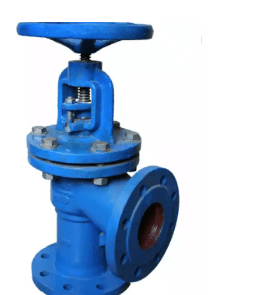Angle Globe Valve
Speciality Valve, as a prominent Angle Globe Valve manufacturer in India. An angle globe valve is a type of valve used in piping systems to control the flow of fluids. It’s called “angle” because of the 90-degree angle between the inlet and outlet ports, which allows for easier installation in tight spaces or where piping is not perfectly aligned. The design of a globe valve includes a movable disk (often called a plug or a disc) that can be raised or lowered to regulate the flow of fluid through the valve.
How does Angle Globe Valve work ?
In a parallel angle globe valve, the fluid flow path runs parallel to the stem movement. This configuration enables more linear flow characteristics, particularly suited for applications requiring precise control over flow rates. As the valve is closed, the plug or disc makes firm contact with the seat, blocking fluid flow entirely. Upon opening the valve by turning the handwheel or actuator, the stem raises the plug away from the seat, permitting fluid passage. Flow rate is regulated by adjusting the plug’s position relative to the seat, allowing operators to finely tune flow rates as needed.
Pressure drop across the valve remains relatively constant over its operational range, ensuring predictable flow characteristics. When fully closed, the plug forms a tight seal against the seat, ensuring complete shut-off when necessary, effectively isolating sections of a piping system. Maintenance is facilitated by the valve’s design, allowing easy access to internal components for inspection, cleaning, or repairs without the need for removing the valve from the pipeline.
The key components of an angle globe valve typically include:
Body: The main structure of the valve that houses the other components.
Bonnet: The cover that provides access to the internals of the valve.
Disc or Plug: The movable component that regulates flow by opening or closing against a seat.
Seat: The stationary surface against which the disc or plug seals to control flow.
Stem: The mechanism that connects the handwheel or actuator to the disc or plug, allowing for the regulation of flow.
Handwheel or Actuator: The component used to manually or automatically operate the valve.
Advantages:
Precise Flow Control
Tight Shut off
Ability to change the direction of fluid flow by 90 degrees
Compact Design
They are used for a wide range of fluids.
Reduced Pressure Drops
Industries:
Petrochemical and Chemical Industries
Oil and Gas Production and Refining
Power Generation (including fossil fuel and nuclear power plants)
Water and Wastewater Treatment
Pulp and Paper Manufacturing
Marine and Shipbuilding
Mining and Mineral Processing
Aerospace and Defense
Automotive Manufacturing
Steel and Metal Processing
Renewable Energy (e.g., solar and geothermal power plants)
Description:
Available materials: Monel, Incoloy, Inconel, F55, F53, F51, Cast iron, SS304, SS316, Titanium, Zirconium, WCB, CF8, CF8M, CF3, CF3M, WC1, WC6, WC9
Size: 1/2″ to 24″
Class: 150 to 2500
Nominal Pressure: PN10 to PN450
Operation: Handwheel, Gear Operated, Electric and Pneumatic Actuated
Ends: Flanged, Buttweld, Socketweld, Threaded
Standards: ASME, API6D, API607, DIN, BS, ANSI

